The tones produced by an electric guitar are greatly affected by its electronic components and wiring configurations. Understanding these concepts can give you the ability to modify your guitar to get the sound you want.
Just like with an acoustic guitar, the shape of an electric guitar and the wood it’s made from affects its tone. However, the physical construction contributes minimally to an electric guitar’s sound.
With an electric guitar, the nature of the output signal is primarily controlled by the type of pickups used and how they’re wired together. Skilled guitar players reading this article will argue that the talents of the player are also a huge factor and while that is true, this article is only concerned with the tone of the guitar itself.
Harmonics
The reason a guitar (or any instrument for that matter) sounds like it does is based on the harmonic content of the sound. Think of a pure sine wave tone produced from a signal generator. It doesn’t sound particularly musical because it lacks the complexity and brightness that comes with higher harmonic content. In general, even harmonics (2, 4, 6, etc.) tend to enrich the sound, making it smooth and pleasant. Odd harmonics tend to add sharpness and punch.
The harmonics that can be acquired by a guitar pickup depend somewhat on where the pickup is placed along the string, but it’s important to understand there is no “perfect” placement position because the location of such a position will vary as notes are played up and down the neck (which shortens the strings).
As you might expect, the pickup positions used on most guitars can acquire mostly even harmonics from the neck pickup and a slight increase in odd harmonics from the bridge pickup. Just because a pickup is placed properly though, does not mean that the harmonics it sees can actually be delivered to the amplifier.
Pickups
A guitar pickup is nothing more than one, sometimes two, coils of wire around one or more magnets. Readers of Nuts & Volts certainly understand that electricity is generated in a wire that resides in a magnetic field that is moving or varying in intensity.
Figure 1 shows a general pickup design. In this case, there are six magnets (one for each string).
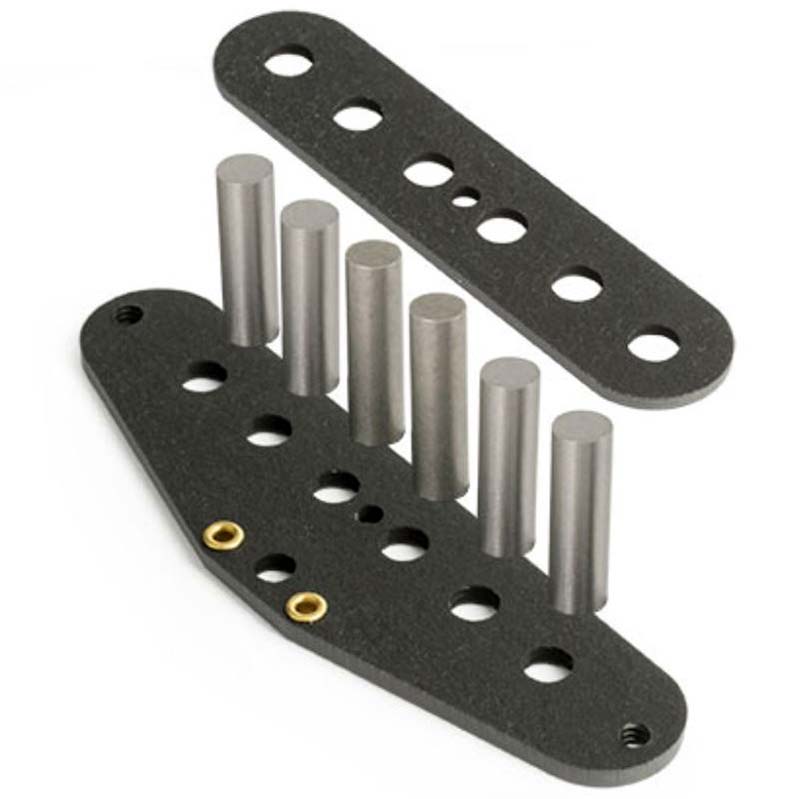
FIGURE 1.
These could be replaced with a single bar magnet. It’s also common for these pole pieces to be nonmagnetic. In such cases, a bar magnet under and touching the poles will provide the magnetic field. Generally, there’s a plastic encasement (often called a bobbin) around the pole pieces. Typically, thousands of turns of wire are wrapped around the bobbin.
If a metal guitar string vibrates above a pole piece, it will disturb the magnetic field which can cause tiny currents to be induced in the coil. These currents will mimic the string movements that disturbed the magnetic field.
Some pickups have a very tall coil (the length of the magnets shown in Figure 1). Alternatively, the coil might be very short which means the same number of turns of wire used on a taller coil would make the short coil denser, which would tend to increase the inductance. However, wire size, core material, and type of magnet can also affect inductance. In some pickups (humbuckers; see sidebar for definitions), there are two coils placed close to each other; both are energized from a single bar magnet. This discussion can get very detailed and overly complex, so let’s simplify it with a summary.
The shape and number of coils — even the type of magnets used and how they are placed — can also affect the shape and intensity of the surrounding magnetic field, which affects the strength of various harmonic signals that are produced in the coil. In addition, the nature of the coil (its dimensions, the magnets, the gauge of wire used, etc.) can dramatically change not only the inductance, but the capacitance and resistance of the coil as well.
Obviously, more turns of wire will increase the inductance, but more turns often require thinner wire and that translates to more resistance. We usually think of coils as being inductors, but each turn of the wire is running parallel with other nearby turns, and that translates to a small capacitance.
Figure 2 shows a very simplified model of a guitar pickup.
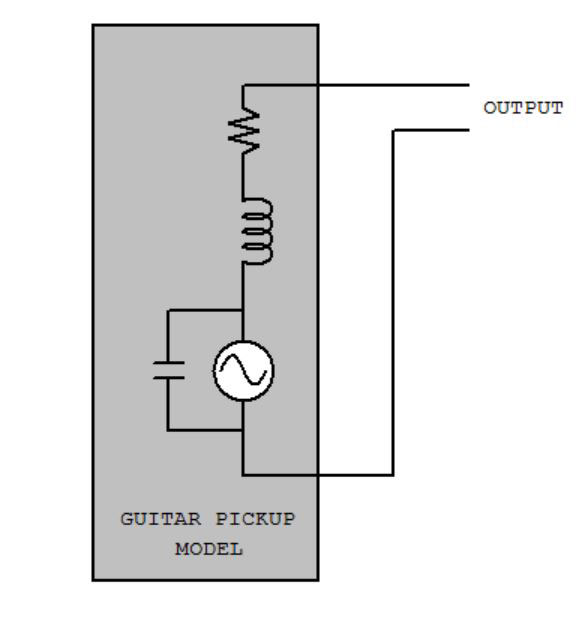
FIGURE 2.
The sine wave generator represents the signals generated by the guitar strings disrupting the pickup’s magnetic field. When the output is applied to a load (the guitar’s volume control for example), some of the signal (especially the higher frequency harmonics) will be dropped across the inductor and won’t be fully transmitted to the amplifier.
The capacitance between coil windings will also tend to short out the higher frequencies, but it (along with the capacitance of the guitar cables and the input capacitance to the amplifier) will react with the pickup’s inductance to create a resonant circuit. This simply means that pickup designs that have more turns of wire or greater inductance due to other designs will fail to pass some of the higher frequency harmonics to the amplifier.
This explains why dual coil humbucker pickups generally have less treble content and will sometimes sound muddy (a term often used by guitarists). It also explains why the physically wider and more dense coils of a P90 pickup tend to place its tone between that of a humbucker and a traditional single coil.
Since various guitars typically have certain types of pickups, we can use that information to predict the type of sound we should expect. Les Paul guitars, for example, usually have humbuckers, so we would expect more bass and less treble. Stratocasters have tall single coils, so they will be brighter with more character. Danelectro guitars wind the coils in their lipstick pickups directly on a bar magnet (no bobbin), so they can get a reasonable output with less coils of wire. This makes their output so bright and clean, it’s often described as bell-like.
Versatility
Sometimes a manufacturer will combine different types of pickups in the same guitar with a switching arrangement that provides a bigger variety of tones than using similar pickups. It’s important, of course, to maintain some similarity between pickups, but mixing pickups can be very beneficial.
Usually, pickups are combined in either series or in parallel, and that choice alone can influence the tone. Two coils in series, for example, will have more inductance which emphasizes the lower frequencies. Parallel pickups will decrease inductance resulting in a brighter sound with more treble content.
Changing the Pickups
I have found that different styles of pickups combined in unique ways can produce interesting results. I love the feel of an SG guitar, but they normally come with two humbuckers that can sound great, but certainly have their limitations. Look at my SG in Figure 3 to see the pickup changes I made.
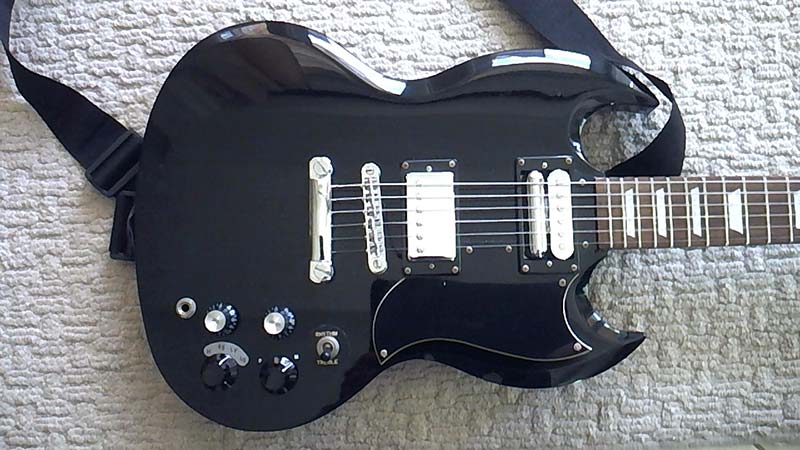
FIGURE 3.
I felt the standard humbuckers needed to be brighter and cleaner for my taste, so I started by replacing the neck humbucker with a pickup I made (see Figures 4 and 5) using a strat single coil with a modest amount of punch and a very clean lipstick pickup.
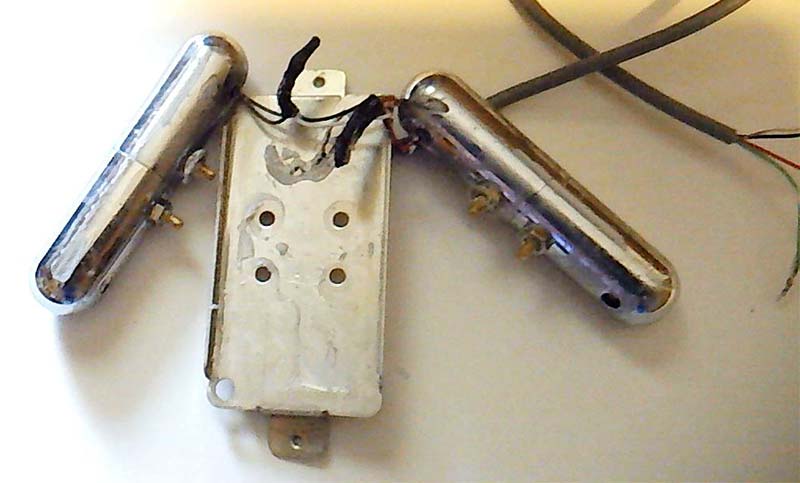
FIGURE 4.
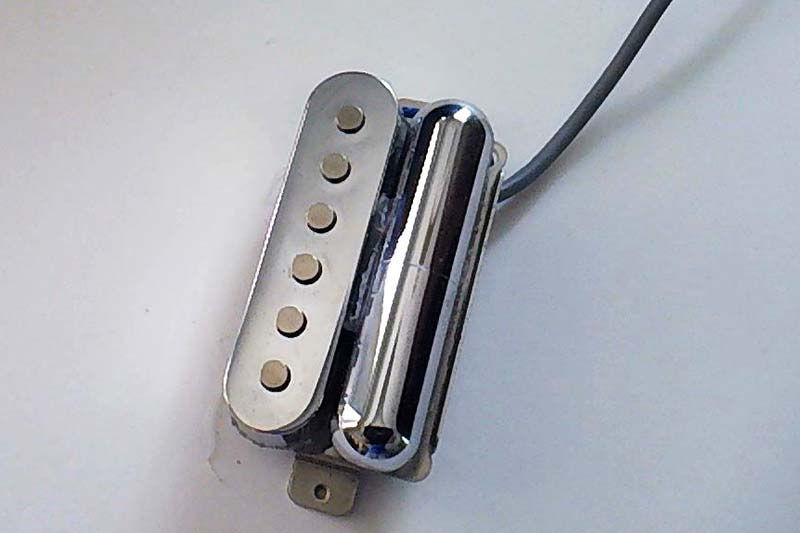
FIGURE 5.
The lipstick was chrome, so I added a chrome cover for the strat pickup. Creating this new custom pickup was easy because I used the baseplate from the lipstick humbucker shown in Figure 4. I used the leftover lipstick in another modification project.
The strat and lipstick pickups were a great complement to each other as neither is overpowering. I was planning on using the original bridge pickup, but found it was not really a good fit for the new neck pickup’s clean sound. I ended up replacing the bridge with a different humbucker that used Alinco 2 magnets. Alinco 2 magnets have a much softer, pleasing sound compared to Alinco 5 versions which were used in the original humbucker. This new bridge pickup blended nicely with the neck.
Changing the Wiring
Changing the pickups made this into a guitar I loved to play, but I was far from satisfied. I often change a guitar’s wiring to provide far more options than those offered by typical pickup mods. Let’s look at this example.
We have two humbucker pickups which means they each have two coils. The original SG wiring allowed you to use either the neck or the bridge, or both in parallel. Some guitars offer the option of splitting the pickups (just using one of the two humbucker coils), but I wanted far more options.
Figure 6 shows the four new configurations I chose to implement.
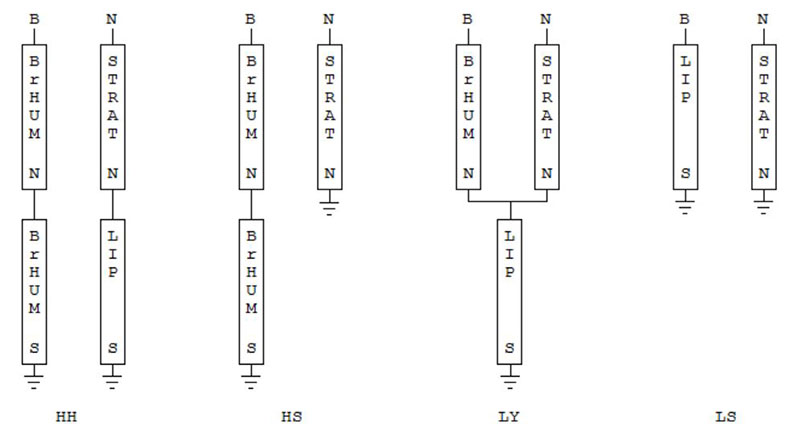
FIGURE 6.
In the first option (labeled HH for two humbuckers), the user can choose the neck or bridge or both in parallel just like the original configuration, but now with much brighter pickups.
The second option in Figure 6 is HS for humbucker-single coil. This is essentially like a typical split coil configuration for the neck pickup. In this case, the softer humbucker and the strat pickup both produce cleaner tones than the original pickups, and the parallel combination is very pleasing.
The third option is one I use a lot (and one I have never seen elsewhere). The lipstick pickup along with one coil from the humbucker and the strat pickup form a Y shape (see Figure 6). The very low inductance of the lipstick pickup enhances both the bridge and neck positions to produce wonderful melodic sounds.
I wanted to have at least one configuration that allowed the lipstick to be used alone. The one I chose is shown in the last option of Figure 6. This option has the added advantage of being able to combine the lipstick and strat pickups in parallel, which gives a clean bright sound that can be ideal for some situations.
The Circuit
Figure 7 shows how a three-pole, four-position rotary switch can be used to implement all the configurations described in Figure 6.
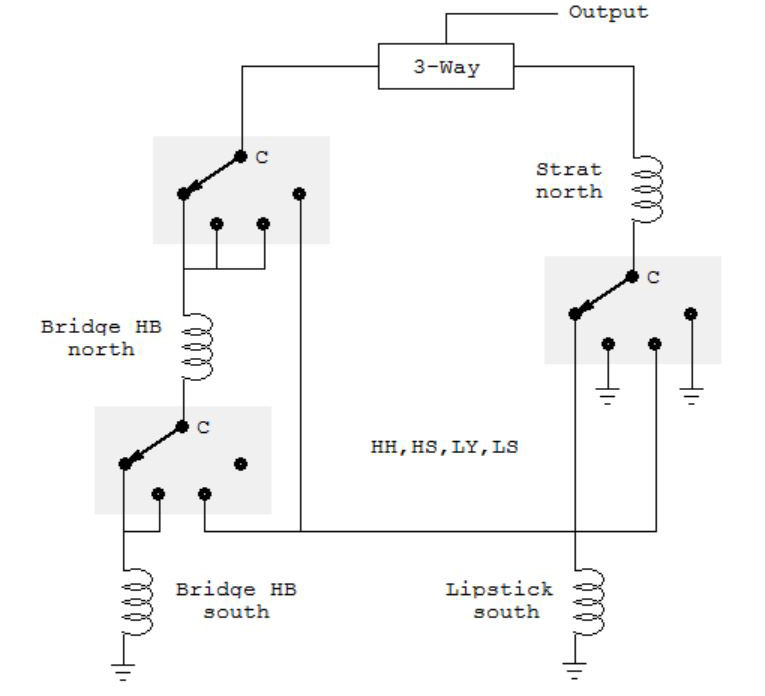
FIGURE 7.
The new guitar is far more versatile than the original, and the clean bright tones are much more to my liking.
The Controls
Figure 8 shows the new controls.
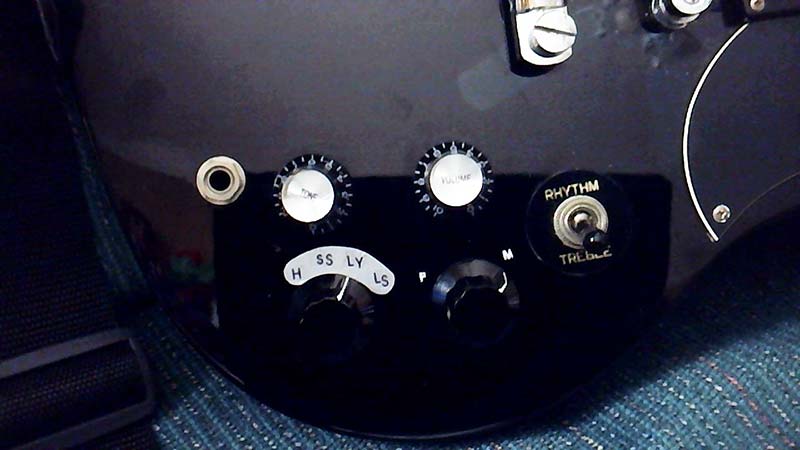
FIGURE 8.
Originally, there were volume and tone controls for each pickup. I chose to use only a master volume and tone which freed up two spaces. The space on the left was used for the four-way switch. Once a configuration is chosen, the original pickup selector switch still chooses the bridge, neck, or both in parallel.
The final freed up spot was used for another mod I eventually added to this guitar. Unfortunately, we’ve run out of space, so that discussion will have to wait. Hopefully though, you can see the value of modifying a guitar to give it more versatility and/or make it more suitable to your ears.
If you enjoyed this brief excursion into a guitar’s pickups and wiring, then you might find value in a book I wrote (see ad) that explores the topics discussed in this article to a much greater depth. NV
DEFINITIONS
Humbucker: A dual coil pickup where the coils and magnetic fields are reversed to cancel noise from florescent lights, etc. The tone is heavy due to significant bass content.
P90: Single coil pickup with two magnets to increase the output. The tone is somewhere between a humbucker and a standard single coil.
Lipstick: Vintage lipstick pickups enclosed their coil in an actual lipstick tube to save costs. Since their coil is wound directly on a bar magnet, they have a bright chime-like tone.









